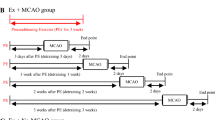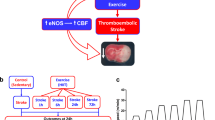Abstract
14-3-3γ is an important early ischemia-inducible protective factor against ischemic cell death in cerebral cortical neurons. We investigated the anti-apoptosis mechanism of enhanced 14-3-3γ mediated by preconditioning exercise-induced brain ischemic tolerance after stroke. Rats were assigned to four groups: exercise and ischemia (Ex group), ischemia and no exercise (No-Ex group), exercise and no ischemia (Ex-only group), and no exercise and ischemia (control group). Rats were trained on a treadmill for 5 days a week for 3 weeks (running speed, 25 m/min; running duration, 30 min/day). After the exercise program, stroke was induced by left middle cerebral artery occlusion. The infarct volume, neurological deficits, and motor function, as well as expression levels of hypoxia-induced factor-1α (HIF-1α), 14-3-3γ, P2X7 receptors, p-β-catenin Ser37, Bax, and caspase 3 were evaluated by immunohistochemistry and western blotting. The expression of HIF-1α and 14-3-3γ significantly increased in neurons and astrocytes in the Ex-only group. HIF-1α was co-expressed with P2X7 receptor- and GFAP-positive astrocytes. After stroke, the Ex group had significantly reduced brain infarction. HIF-1α and 14-3-3γ significantly increased in the Ex group compared to the No-Ex group. In addition, p-β-catenin Ser37 significantly increased following elevated 14-3-3γ; in contrast, Bax and caspase 3 were significantly reduced in the Ex group. Our findings suggest that preconditioning exercise prior to ischemia induces neuron- and astrocyte-mediated brain ischemic tolerance through increased expression of HIF-1α and 14-3-3γ, which are intrinsic protective factors; the upregulated 14-3-3γ induced by preconditioning exercise reduces ischemic neuronal cell death through the 14-3-3γ/p-β-catenin Ser37/Bax/caspase 3 anti-apoptotic pathway.







Similar content being viewed by others
References
Aboutaleb N, Shamsaei N, Khaksari M, Erfani S, Rajabi H, Nikbakht F (2015) Pre-ischemic exercise reduces apoptosis in hippocampal CA3 cells after cerebral ischemia by modulation of the Bax/Bcl-2 proteins ratio and prevention of caspase-3 activation. J Physiol Sci 65:435–443
Cao WD, Kawai N, Miyake K, Zhang X, Fei Z, Tamiya T (2014) Relationship of 14-3-3zeta (ζ), HIF-1α, and VEGF expression in human brain gliomas. Brain Tumor Pathol 31:1–10
Chen XQ, Yu ACH (2002) The association of 14-3-3γ and actin plays a role in cell division and apoptosis in astrocytes. Biochem Biophys Res Commun 296(3):657–663
Chen XQ, Chen JG, Zhang Y, Hsiao WW, Yu AC (2003) 14-3-3Gamma is upregulated by in vitro ischemia and binds to protein kinase Raf in primary cultures of astrocytes. Glia 42:315–324
Chen WQ, Viidik A, Skalicky M, Höger H, Lubec G (2007) Hippocampal signaling cascades are modulated in voluntary and treadmill exercise rats. Electrophoresis 28:4392–4400
Dong Y, Liu HD, Zhao R, Yang CZ, Chen XQ, Wang XH, Lau LT, Chen J, Yu AC (2009) Ischemia activates JNK/c-Jun/AP-1 pathway to up-regulate 14-3-3gamma in astrocyte. J Neurochem 109:182–188
Dong Y, Zhao R, Chen XQ, Yu AC (2010) 14-3-3gamma and neuroglobin are new intrinsic protective factors for cerebral ischemia. Mol Neurobiol 41:218–231
Dornbos D 3rd, Zwagerman N, Guo M, Ding JY, Peng C, Esmail F, Sikharam C, Geng X, Guthikonda M, Ding Y (2013) Preischemic exercise reduces brain damage by ameliorating metabolic disorder in ischemia/reperfusion injury. J Neurosci Res 91:818–827
Feng R, Zhang M, Wang X, Li WB, Ren SQ, Zhang F (2014) Pre-ischemic exercise alleviates oxidative damage following ischemic stroke in rats. Exp Ther Med 8:1325–1329
Guo M, Cox B, Mahale S, Davis W, Carranza A, Hayes K, Sprague S, Jimenez D, Ding Y (2008) Pre-ischemic exercise reduces matrix metalloproteinase-9 expression and ameliorates blood–brain barrier dysfunction in stroke. Neuroscience 151:340–351
Hirayama Y, Ikeda-Matsuo Y, Notomi S, Enaida H, Kinouchi H, Koizumi S (2015) Astrocyte-mediated ischemic tolerance. J Neurosci 35:3794–3805
Jang SW, Liu X, Fu H, Rees H, Yepes M, Levey A, Ye K (2009) Interaction of Akt-phosphorylated SRPK2 with 14-3-3 mediates cell cycle and cell death in neurons. J Biol Chem 284:24512–24525
Lai XJ, Ye SQ, Zheng L, Li L, Liu QR, Yu SB, Pang Y, Jin S, Li Q, Yu AC, Chen XQ (2014) Selective 14-3-3γ induction quenches p-β-catenin Ser37/Bax-enhanced cell death in cerebral cortical neurons during ischemia. Cell Death Dis 5:e1184
Li J, Ding YH, Rafols JA, Lai Q, McAllister JP 2nd, Ding Y (2005) Increased astrocyte proliferation in rats after running exercise. Neurosci Lett 386:160–164
Monif M, Reid CA, Powell KL, Smart ML, Williams DA (2009) The P2 × 7 receptor drives microglial activation and proliferation: a trophic role for P2 × 7R pore. J Neurosci 29:3781–3791
Narayanan SV, Perez-Pinzon MA (2017) Ischemic preconditioning treatment of astrocytes transfers ischemic tolerance to neurons. Cond Med 1:2–8
Ogle ME, Gu X, Espinera AR, Wei L (2012) Inhibition of prolyl hydroxylases by dimethyloxaloylglycine after stroke reduces ischemic brain injury and requires hypoxia inducible factor-1α. Neurobiol Dis 45:733–742
Otsuka S, Sakakima H, Sumizono M, Takada S, Terashi T, Yoshida Y (2016) The neuroprotective effects of preconditioning exercise on brain damage and neurotrophic factors after focal brain ischemia in rats. Behav Brain Res 303:9–18
Pang Y, Chai CR, Gao K, Jia XH, Kong JG, Chen XQ, Vatcher G, Chen JG, Vatcher G, Chen JG, Yu AC (2015) Ischemia preconditioning protects astrocytes from ischemic injury through 14-3-3γ. J Neurosci Res 93:1507–1518
Prabhakaran S, Ruff I, Bernstein RA (2015) Acute stroke intervention: a systematic review. JAMA 313:1451–1462
Ryou MG, Liu R, Ren M, Sun J, Mallet RT, Yang SH (2012) Pyruvate protects the brain against ischemia–reperfusion injury by activating the erythropoietin signaling pathway. Stroke 43:1101–1107
Sakakima H, Khan M, Dhammu TS, Shunmugavel A, Yoshida Y, Singh I, Singh AK (2012) Stimulation of functional recovery via the mechanisms of neuro repair by S-nitrosoglutathione and motor exercise in a rat model of transient cerebral ischemia and reperfusion. Restor Neurol Neurosci 30:383–396
Yang J, Liu C, Du X, Liu M, Ji X, Du H, Zhao H (2018) Hypoxia inducible factor 1α plays a key role in remote ischemic preconditioning against stroke by modulating inflammatory responses in rats. J Am Heart Assoc 7:e007589
Zhang F, Wu Y, Jia J (2011) Exercise preconditioning and brain ischemic tolerance. Neuroscience 177:170–176
Zhao H, Shimohata T, Wang JQ, Sun G, Schaal DW, Sapolsky RM, Steinberg GK (2005) Akt contributes to neuroprotection by hypothermia against cerebral ischemia in rats. J Neurosci 25:9794–9806
Zhao J, Meyerkord CL, Du Y, Khuri FR, Fu H (2011) 14-3-3 proteins as potential therapeutic targets. Semin Cell Dev Biol 22:705–712
Zhou XY, Hu DX, Chen RQ, Chen XQ, Dong WL, Yi CL (2017) 14-3-3 isoforms differentially regulate NFκB signaling in the brain after ischemia-reperfusion. Neurochem Res 42:2354–2362
Acknowledgements
The authors greatly appreciate the assistance of Ms. Megumi Sumizono and Mr. Koki Ueda, and are grateful to Ms. Hui Gao for excrement technical assistance. This work was supported by grant from the JSPS KAKENHI (Grant no. JP17K01459 to Harutoshi Sakakima). This study was supported by grants from the JSPS KAKENHI (Grant no. JP16K10746 to Kiyoshi Kikuchi), General Insurance Association of Japan (to Kiyoshi Kikuchi), ZENKYOREN (National Mutual Insurance Federation of Agricultural Cooperatives) of Japan (to Kiyoshi Kikuchi), and Mitsui Sumitomo Insurance Welfare Foundation of Japan (to Kiyoshi Kikuchi).
Author information
Authors and Affiliations
Corresponding authors
Ethics declarations
Conflict of interest
The authors declare no competing financial interests.
Ethical approval
All experiments were performed according to national and institutional guidelines and were approved by the appropriate authority.
Additional information
The original version of this article was revised: both the Figs. 2e and 7e have been published incorrectly. Hence Figs. 2 and 7 are corrected.
Rights and permissions
About this article
Cite this article
Otsuka, S., Sakakima, H., Terashi, T. et al. Preconditioning exercise reduces brain damage and neuronal apoptosis through enhanced endogenous 14-3-3γ after focal brain ischemia in rats. Brain Struct Funct 224, 727–738 (2019). https://doi.org/10.1007/s00429-018-1800-4
Received:
Accepted:
Published:
Issue Date:
DOI: https://doi.org/10.1007/s00429-018-1800-4




